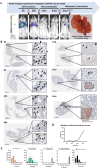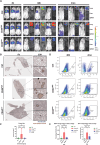Identification and Characterization of Metastasis-Initiating Cells in ESCC in a Multi-Timepoint Pulmonary Metastasis Mouse Model
- PMID: 38864342
- PMCID: PMC11321633
- DOI: 10.1002/advs.202401590
Identification and Characterization of Metastasis-Initiating Cells in ESCC in a Multi-Timepoint Pulmonary Metastasis Mouse Model
Abstract
Metastasis is the biggest obstacle to esophageal squamous cell carcinoma (ESCC) treatment. Single-cell RNA sequencing analyses are applied to investigate lung metastatic ESCC cells isolated from pulmonary metastasis mouse model at multiple timepoints to characterize early metastatic microenvironment. A small population of parental KYSE30 cell line (Cluster S) resembling metastasis-initiating cells (MICs) is identified because they survive and colonize at lung metastatic sites. Differential expression profile comparisons between Cluster S and other subpopulations identified a panel of 7 metastasis-initiating signature genes (MIS), including CD44 and TACSTD2, to represent MICs in ESCC. Functional studies demonstrated MICs (CD44high) exhibited significantly enhanced cell survival (resistances to oxidative stress and apoptosis), migration, invasion, stemness, and in vivo lung metastasis capabilities, while bioinformatics analyses revealed enhanced organ development, stress responses, and neuron development, potentially remodel early metastasis microenvironment. Meanwhile, early metastasizing cells demonstrate quasi-epithelial-mesenchymal phenotype to support both invasion and anchorage. Multiplex immunohistochemistry (mIHC) staining of 4 MISs (CD44, S100A14, RHOD, and TACSTD2) in ESCC clinical samples demonstrated differential MIS expression scores (dMISs) predict lymph node metastasis, overall survival, and risk of carcinothrombosis.
Keywords: early cancer metastasis; early metastasis microenvironment; esophageal squamous cell carcinoma; metastasis biomarkers; metastasis‐initiating cells; multiplex staining; single‐cell transcriptome sequencing.
© 2024 The Author(s). Advanced Science published by Wiley‐VCH GmbH.
Conflict of interest statement
The authors declare no conflict of interest.
Figures







References
MeSH terms
Substances
Grants and funding
- C7065-18GF/Hong Kong Research Grant Council
- C7026-18GF/Hong Kong Research Grant Council
- C4039-19GF/Hong Kong Research Grant Council
- R4017-18/Research Impact Fund
- R1020-18F/Research Impact Fund
- R7022-20/Research Impact Fund
- 17119322/General Research Fund
- 82072738/National Natural Science Foundation of China
- 82273483/National Natural Science Foundation of China
- ZDSYS20210623091811035/Shenzhen Key Laboratory for cancer metastasis and personalized therapy
- JCYJ20220818103014030/Shenzhen Science and Technology Program
- KQTD20180411185028798/Shenzhen Science and Technology Program
- JCYJ20220818103012025/Shenzhen Science and Technology Program
- 2020B1212030004/Guangdong Science and Technology Department
- 2019BT02Y198/Guangdong Provincial Introduction of Innovative Research and Development Team
- T12-703/22-R/Research Grants Council, University Grants Committee
LinkOut - more resources
Full Text Sources
Medical
Molecular Biology Databases
Research Materials
Miscellaneous
